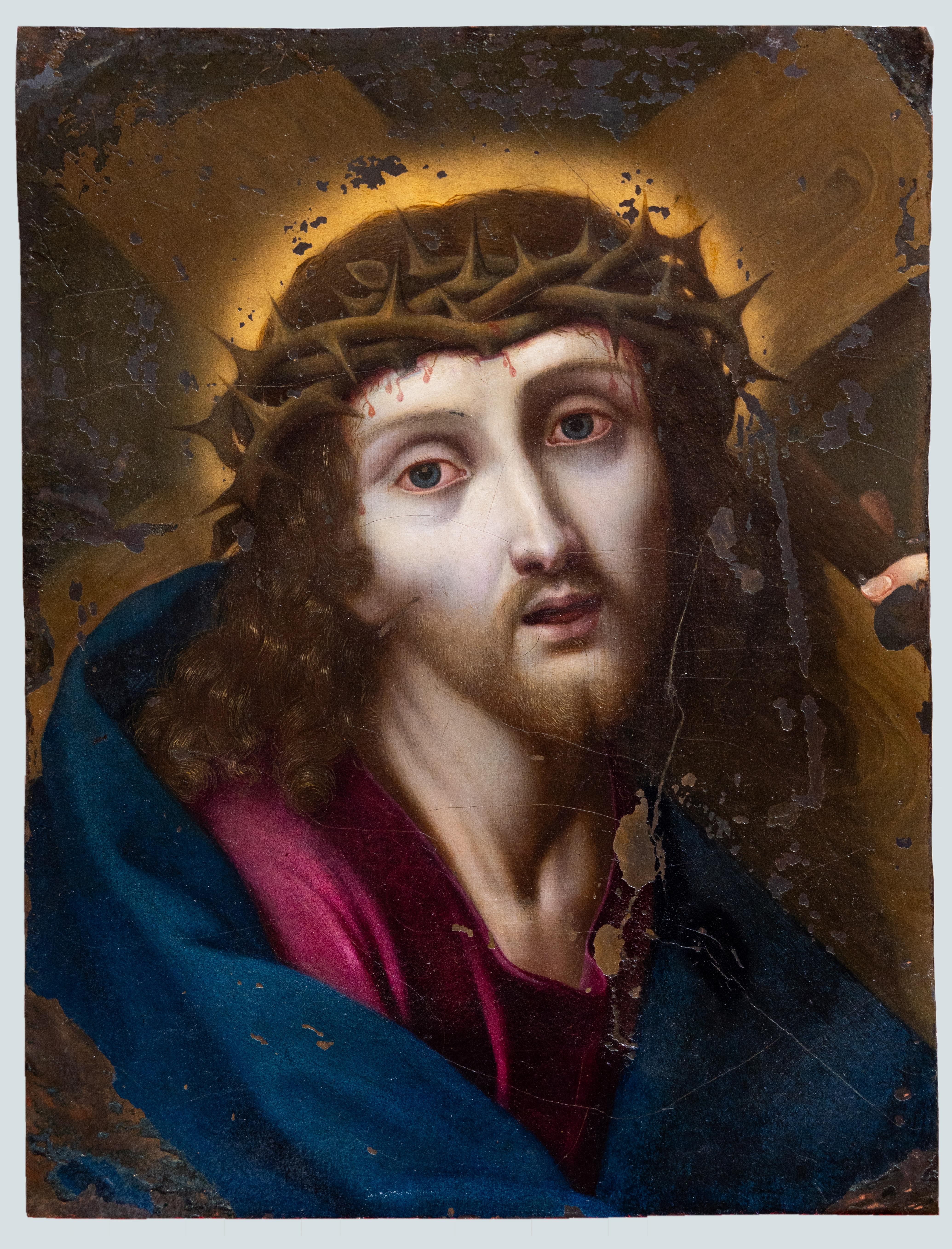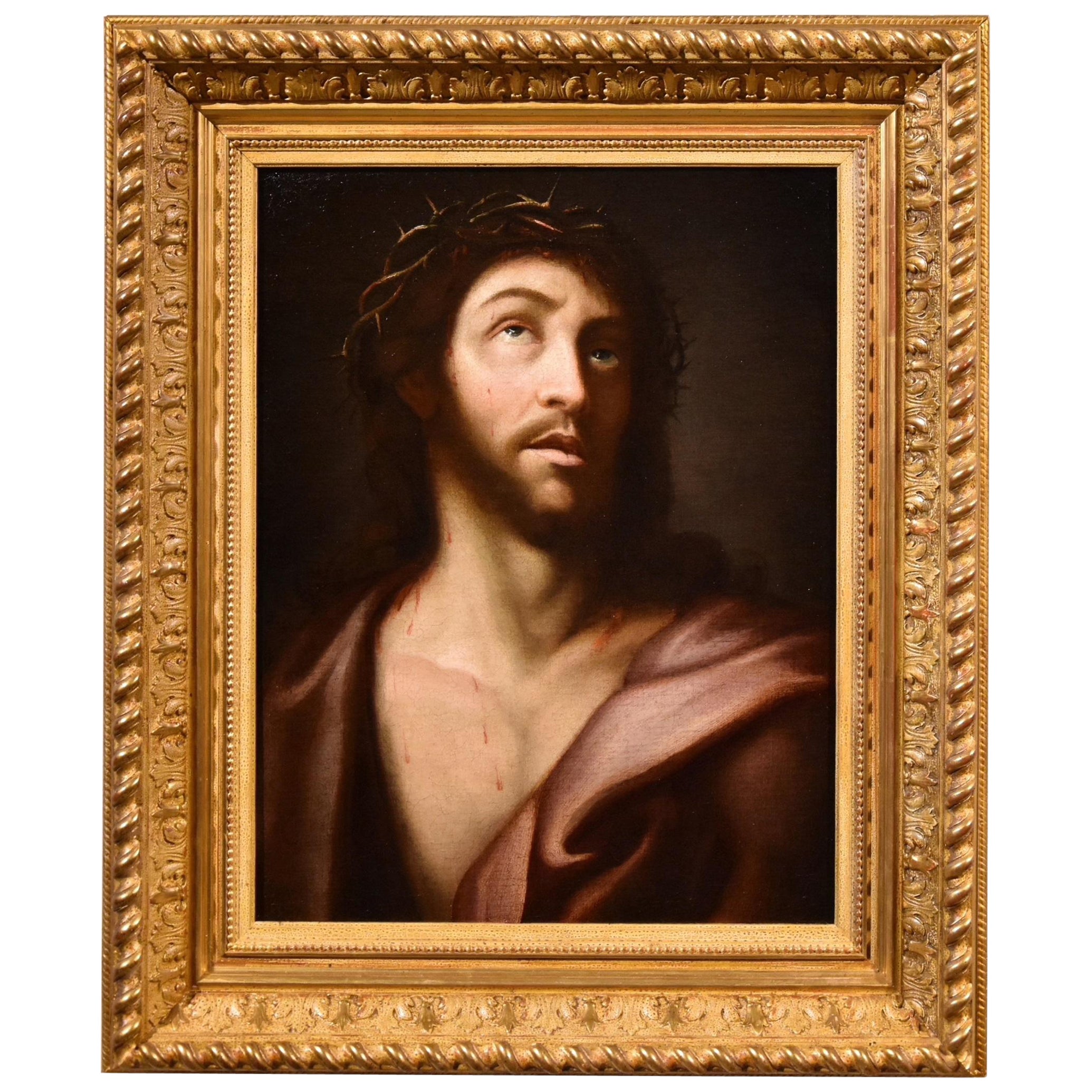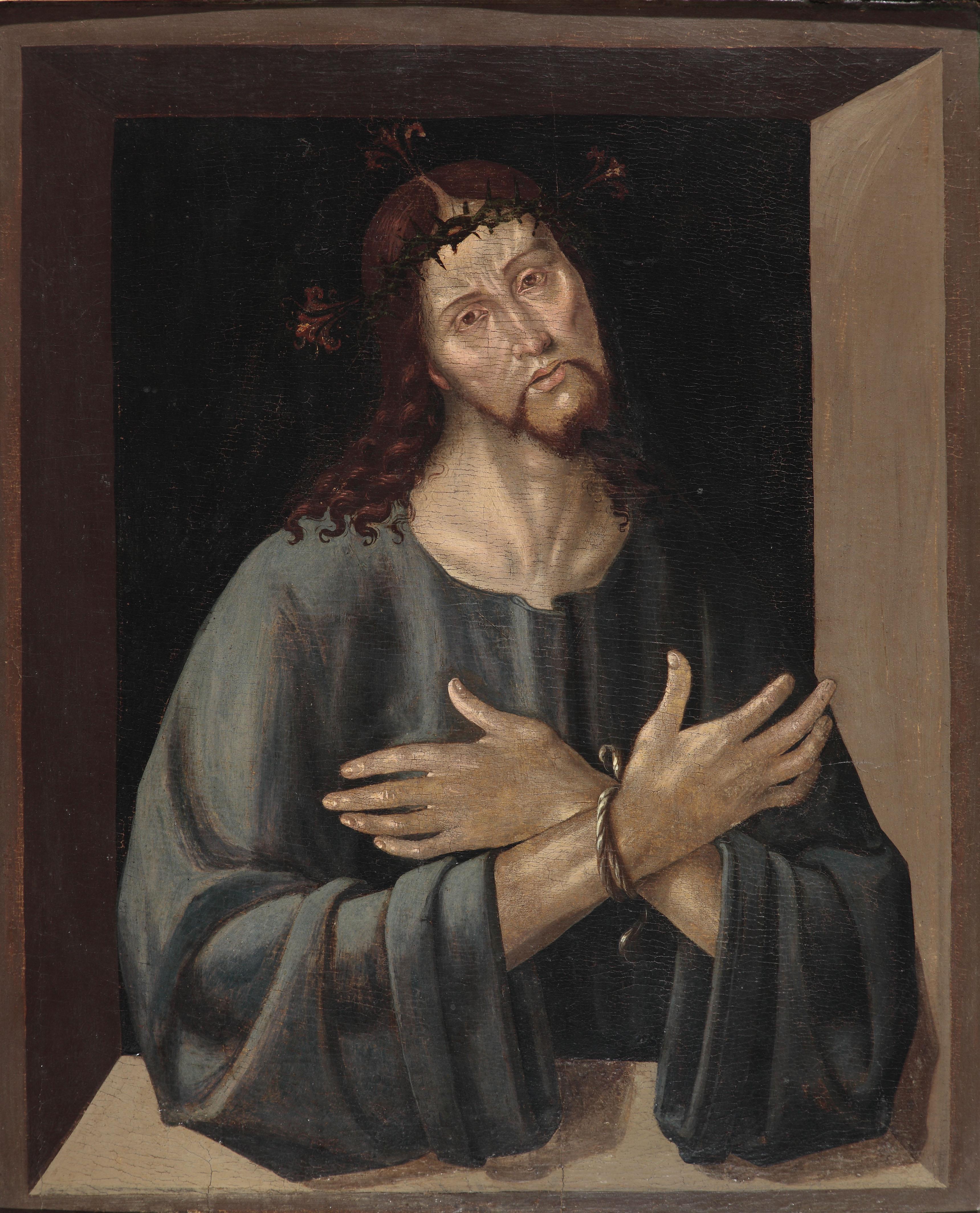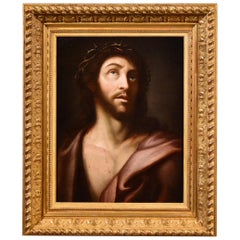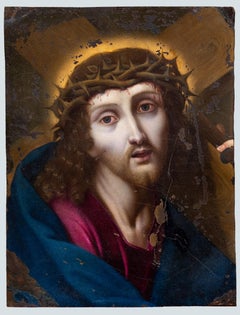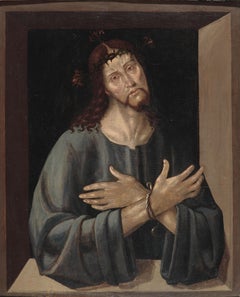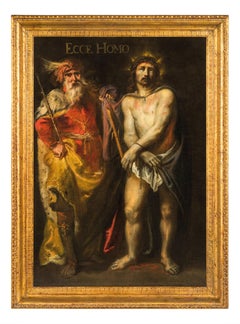Items Similar to Ecce Homo Christ Metsys 16th Century Paint Oil on table Flemish Old master
Want more images or videos?
Request additional images or videos from the seller
1 of 16
Ecce Homo Christ Metsys 16th Century Paint Oil on table Flemish Old master1520-1620
1520-1620
$7,342.97
$9,178.7120% Off
£5,454.60
£6,818.2520% Off
€6,136
€7,67020% Off
CA$10,130.14
CA$12,662.6720% Off
A$11,135.81
A$13,919.7620% Off
CHF 5,852.47
CHF 7,315.5920% Off
MX$135,229.28
MX$169,036.6020% Off
NOK 73,008.10
NOK 91,260.1220% Off
SEK 69,170.04
SEK 86,462.5520% Off
DKK 46,710.41
DKK 58,388.0120% Off
About the Item
16th-century Flemish master
Circle of Quentin Metsys (Leuven, 1466 - Antwerp, 1530)
Ecce Homo
oil on panel
cm. 34 x 23
with frame 47 x 37 (not contemporary)
An important painting on panel, depicting the intense face of the suffering Christ crowned with thorns, in the more traditional iconography of Ecce Homo, one of the most representative Christian depictions in Old Master painting, which Flemish painters have emerged from for intensity and dramatic realism.
The painting in fact reveals typological and formal characteristics derived from the 16th century North European tradition, showing particular affinities with the works of the Flemish Quentin Massys (or Metsijs), founder of the Antwerp School and one of the greatest Flemish interpreters of this subject;
We can mention among many works his Ecce Homo dating from 1516 and currently housed in the Musée des Beaux-Arts de Dunkerque (see details)
Musée des Beaux-Arts de Dunkerque
Compared to this model, this work exhibits more robust workmanship and denser impastoes of colour, which in our opinion point towards a rather late 16th century date.
Christ, whose figure emerges against a dark background, is depicted with his head framed by a luminous reflection, on which is placed the crown of intertwined thorns. His gaze is dull with his eyes half-closed, flushed, in a resigned attitude disfigured by pain, furrowed by tears and drops of blood.
Important in this painting is the study of Christ's expression and gaze, with his eyes turned downwards, in sign of pain, dense with a phatos capable of conveying to the viewer the suffering of this episode of the Passion.
Ecce Homo is the Gospel episode during which Jesus, awaiting his condemnation after the scourging, is presented to the people by Pontius Pilate, then the Roman governor of Judea. The expression literally means ‘Behold the Man’, and was the phrase uttered by Pilate to designate the suffering of Jesus scourged and crowned with thorns.
The face suggests that the author undoubtedly carefully studied the works of other artists for physiognomy, i.e. the discipline that sought to study the character of people based on their physical appearance, and whether there was any relationship between appearance and character.
ADDITIONAL INFORMATION:
The work is sold complete with a wooden frame and comes with a certificate of authenticity and descriptive iconographic card.
We take care of and organise the transport of the purchased works, both for Italy and abroad, through professional and insured carriers. It is also possible to see the painting in the gallery in Riva del Garda, we will be happy to welcome you and show you our collection of works.
In the case of purchase of the work by non-Italian customers, it will be necessary to obtain an export permit, which takes about 10/20 days; our gallery will take care of the whole phase until it is obtained. All costs of this operation are included.
Contact us, without obligation, for any additional information.
- Creation Year:1520-1620
- Dimensions:Height: 18.51 in (47 cm)Width: 14.57 in (37 cm)
- Medium:
- Movement & Style:
- Circle Of:Quentin Metsys (Leuven, 1466 - Antwerp, 1530)
- Period:
- Condition:
- Gallery Location:Riva del Garda, IT
- Reference Number:1stDibs: LU988114996762
About the Seller
4.9
Platinum Seller
Premium sellers with a 4.7+ rating and 24-hour response times
Established in 2017
1stDibs seller since 2018
260 sales on 1stDibs
Typical response time: <1 hour
- ShippingRetrieving quote...Shipping from: Riva del Garda, Italy
- Return Policy
Authenticity Guarantee
In the unlikely event there’s an issue with an item’s authenticity, contact us within 1 year for a full refund. DetailsMoney-Back Guarantee
If your item is not as described, is damaged in transit, or does not arrive, contact us within 7 days for a full refund. Details24-Hour Cancellation
You have a 24-hour grace period in which to reconsider your purchase, with no questions asked.Vetted Professional Sellers
Our world-class sellers must adhere to strict standards for service and quality, maintaining the integrity of our listings.Price-Match Guarantee
If you find that a seller listed the same item for a lower price elsewhere, we’ll match it.Trusted Global Delivery
Our best-in-class carrier network provides specialized shipping options worldwide, including custom delivery.More From This Seller
View AllEcce Homo Coxie Paint 16/17th Century Paint Oil on table Old master Flemish Art
Located in Riva del Garda, IT
Circle of Michael Coxie (Malines, 1499 - Malines, 1592)
Ecce Homo with Pontius Pilate
Oil on panel
Flemish school 16th-17th century
112 x 81 cm - framed 121 x 90 cm.
The proposed p...
Category
16th Century Old Masters Paintings
Materials
Oil
$8,516 Sale Price
20% Off
Ecce Homo Castello 17th Century Paint Oil on canvas Old master Genoese school
Located in Riva del Garda, IT
17th-century Genoese School
Workshop of Valerio Castello (Genoa, 1624 - Genoa, 1659)
Ecce homo
Oil on canvas
117 x 99 cm.
In frame 138 x 118 cm.
The Ecce Homo, the subject of our ...
Category
17th Century Old Masters Paintings
Materials
Oil
$15,028 Sale Price
20% Off
Ecce Homo Christ Paint Oil on canvas 17th Century Old master Leonardo Italian
Located in Riva del Garda, IT
Lombard painter of the seventeenth century
Ecce Homo
Oil painting on canvas
56 x 43 cm. , framed 75 x 63 cm.
Provenance: Florence, Pandolfini, 5.10.2021, lot 209
The proposed canv...
Category
17th Century Old Masters Paintings
Materials
Oil
$5,973 Sale Price
20% Off
Christ Cross Religious Van Dyck 17th Century Paint Oil on canvas Old master
By Anthoon van Dyck (Antwerp 1599 - London 1641)
Located in Riva del Garda, IT
Anthoon van Dyck (Antwerp 1599 - London 1641) workshop
Christ Carrying the Cross - 17th century
Oil on canvas (120 x 94 cm - framed 140 x 112 cm).
This remarkable canvas, depic...
Category
17th Century Old Masters Paintings
Materials
Oil
$17,282 Sale Price
20% Off
Jesus Son Salvi Paint Oil on canvas Old master 17th Century Italian Religious
Located in Riva del Garda, IT
Ancient painting depicting Jesus with the Commissioner's son
(Alternative reading: St. Joseph with the Child, or the 'Paternity')
Giovan Battista Salvi known as "the Sassoferrato" (1609 - 1685) circle / follower
Oil painting on canvas
76 x 59 cm. -With frame in the shape of a small temple, not coeval 99 x 84 cm.
The interesting canvas that we are pleased to offer you recalls the iconographic model of classic paternity, which traditionally sees Saint Joseph holding the sleeping baby Jesus...
Category
17th Century Old Masters Paintings
Materials
Oil
$5,413 Sale Price
40% Off
Christ Salvator Mundi Paint Oil on copper 16/17th Century Flemish school
Located in Riva del Garda, IT
Antique painting depicting the Face of Christ as Salvator Mundi
Flemish painter, 16th-17th century
Oil on copper
22 x 18 cm./ framed 42 x ...
Category
16th Century Old Masters Paintings
Materials
Oil
$4,107 Sale Price
20% Off
You May Also Like
Ecce Homo, after Carlo Dolci (1616–1686)
Located in GB
Ecce Homo is a superb, striking and emotive Old Master in oil on copper after the renowned Italian Baroque artist Carlo Dolci. The "Ecce Homo" shows the figure of Christ before His c...
Category
17th Century Baroque Figurative Paintings
Materials
Copper
Escuela española (XVIII) - Ecce Homo - Óleo sobre tabla
Located in Sant Celoni, ES
La obra no va firmada
Se presenta enmarcada con un marco de principios del siglo xx en madera tallada
El estado de la obra se puede ver, presenta craquelaciones y faltas de pintura...
Category
Mid-18th Century Old Masters Figurative Paintings
Materials
Oil
15th Century By Maestro della Pala Sforzesca Ecce Homo Tempera on Panel
Located in Milano, Lombardia
15th Century Maestro della Pala Sforzesca
Title: Ecce Homo
Medium: Tempera on Panel
Dimensions: without frame 64.9 x 53.2 – with frame 82 x 70 x 5 cm
Beautiful "cassetta" frame in e...
Category
15th Century and Earlier Old Masters Figurative Paintings
Materials
Panel, Tempera
Old Master Flemish Oil on Canvas Baroque Painting Jesus Christ Ecce Homo 1630
Located in Portland, OR
An important Old Master oil on canvas painting by the Flemish artist, Jan Cossiers, a follower of the style of Caravaggio (1600-1671).
Born in Antwerp in 1600, Jan Cossiers was a pupil of his father, the painter Antoon Cossiers (died 1646/1647), and also studied under Cornelis de Vos...
Category
17th Century Baroque Figurative Paintings
Materials
Canvas, Oil
17th Century Flemish School after Le Correge, "Ecce Homo"
Located in Madrid, ES
17th-century Flemish School, after Le Correge, "Ecce Homo,"
oil on copper in a Louis XVI frame
51 x 41 cm
(small parts missing),
with collector's inscriptions on the back
good condit...
Category
Antique 17th Century Dutch Baroque Paintings
Materials
Paint
Large 18th Century Flemish Old Master Oil Painting Christ on the Cross Crucifix
Located in Cirencester, Gloucestershire
The Crucifixion
Christ on the Cross
Flemish School, 18th Century
oil on canvas laid on panel, unframed
panel : 31 x 18.5 inches
Provenance: private collection, UK
Condition: very goo...
Category
18th Century Old Masters Figurative Paintings
Materials
Oil
More Ways To Browse
Flemish Paintings
Antique Governor
Old Master Flemish
Flemish Painters
Italian Oil Painting Old Man
Antwerp Art
Flemish Masters
Flemish Oil Painting
16th Century Old Master Painting
Flemish Frame
Antique Flemish Frame
Christ Oil Painting
Antique Christian Painting
Crown Of Thorns
Old Master Painting Flemish
Old Master Christ
Flemish Table
Pontius Pilate
